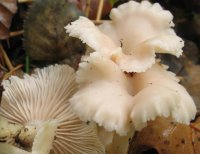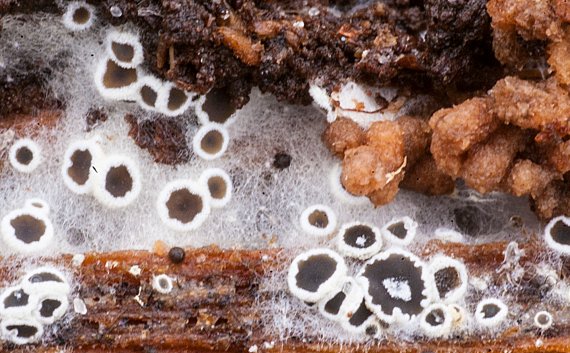Eriopezia ceasia, one of the newly named mushrooms. Photo: N. Dam
The list of new names released by the Dutch Mycological Society (NVM) feels and reads like a poem.
Kegelmosilia, Iepenpuntkogeltje Kraagkuiltje, Knikkerpluis Kroonbekerzwam
Klei-aardtong, Reikhalsje Gewimperd menhirzwammetje Obscuur geleischijfje Roestparasiet!
500 new names! Where do all these mushrooms come from?
‘Between 100 and 150 new species are discovered in the Netherlands and Flanders each year. These are often very small species, barely a millimetre in size. The 500 new names cover a backlog of about three years. Do note that these are species that are new for the Dutch and Flemish. Once in a while, a species that is entirely new to science is discovered.’

Do their scientific names not suffice?
‘No, they do not. Each organism that occurs in our country must have both a scientific and a Dutch name. That is the policy and we comply. It used to be different. The oldest book on mushrooms I own is from the end of the eighteenth century. It contains only two Dutch names. A first attempt at naming all common and conspicuous mushrooms was made in the 1920’s. Several thousand were named until the 1990’s. The lion’s share has been done in the last two decades. We have been harmonising the names with the Flemish in the last couple of years.’
What makes a good name for a mushroom?
‘We have a set of rules that a name is required to satisfy. First of all, a name must express a specific characteristic of the mushroom and should preferably not contain too many syllables. I find the name beiteltje (Eng.: ‘tiny chisel’) a nice example of this. It is a small, triangular mushroom. The name is strikingly appropriate. Spleetlip (Eng.: ‘cleft lip’) is another good example. These are ideal names. Names preferably also consist of a single adjective. We try to avoid geographical indications, because you never know where that mushroom might show up next. We do not name after people, and a name should not be misleading. The most beautiful names are the ones that are poetic. Like elfenbankje (Eng.: ‘tiny elf bench’), heksenschermpje (Eng.: ‘little witch’s shade’) or judasoor (Eng.: ‘Judas’ ear’).
The most beautiful names are the ones that are poetic
Thom Kuyper
Could you give an example of a name you came up with?
‘The Adonistrechterzwam (Eng.: ‘Adonis Clitocybe’). Mushrooms of the Clitocybe genus are generally very pale. This species is pinkish. With fitting exaggeration, I have called it the Adonis Clitocybe.’
Is it easy to keep coming up with new names, time and time again?‘The people who discover a new species are allowed to suggest a name. We try to follow that suggestion as much as possible. But in some cases, we diverge from it, because it is incorrect Dutch, or because a name already exists in Flemish. As more species are discovered, the names become more and more dull, because we run out of vocabulary.’

Couldn’t you simply translate names from other languages?
‘That is difficult to do, because few countries have gotten as far in the naming as the Netherlands. The French tend to simply Gallicise the scientific name. The English don’t name them at all. The Germans do, somewhat, but they are especially behind with the small mushrooms.’
Do you need a knowledge of mushrooms to do this, or a good linguistic feeling?
‘A lot of work has already been done in the preliminary stage. For one, we do not have to check whether a discovery is truly new or not. In that sense, a good knowledge of nouns and adjectives would suffice. I have named mushrooms I had never seen before. There is no other possibility. Around 5000 species occur in our country. No one has seen more than half of them.’

